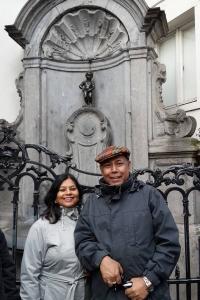
We reached Brussels at 10 pm when the sun had just dipped below the horizon in the wake of a pink sky trailing swathes of orange tinted clouds. As we tried to fit our luggage into the tiny hotel lift, we wondered why most of Europe believed in tiny spaces hung high up. However, when we reached our room and noticed the bidet in the toilet, we cracked a smile, ‘Okay! So at least some of Europe is civilized.’
Next morning, we woke to clear skies, a sharp, lively breeze, and the chimes of church bells. Wherever we stayed across Europe, whether inside a town or outside in the countryside, the distant pealing of church bells remained a charming motif. After a continental breakfast of freshly-baked, heavenly-smelling croissants, cheese and fruit, we set out to explore Brussels.
Europe has many elaborate medieval town squares, but none is as ornate as the Grand Place in Brussels, our first stop that morning. The stunning 17th century Flemish façades of the guild houses on this cobble stone square tells you about the days when Brussels was one of Europe’s main centres of industry.
You have to walk through dark, narrow cobblestone alleys to reach the Grand Place. Tall Gothic, Renaissance and Baroque facades of intricately-crafted guild houses tower above you on all four sides, taking you back four centuries. I had never seen such a picturesque square.
The guild houses used to be the corporate headquarters for large groups of merchants and tradesmen in the Low Countries. These corporates had been so economically and politically powerful that their leaders met in the houses to discuss new rules and regulations within their own trade, even making recommendations to the city administration. And nowhere in Europe today will you find guild houses as perfectly preserved as those in Brussels’ Grand Place.
The adornments of gilded statues and carved symbols relating to their trade show the influence of the guild houses even today. Their power was so great that when the guild houses were completely destroyed by the French bombardment in 1695, they were rebuilt in stone within 5 years.
Walking away from the square through curious stone-paved lanes, we passed shop windows displaying the delicate laces and beautiful tapestry-work, Belgium is so famous for. Of course, the prices were too exorbitant to consider purchases but it didn’t cost to drool over them. Sandwiched between the lacemakers were tiny cafes selling the renowned Belgian chocolates, again pretty expensive. Our tour manager consoled us by saying we should wait till we reached Switzerland to bite into chocolates. However, now I wish we had tried out a teeny-weeny piece of the Belgian variant.
We turned a corner and came upon Manneken Pis meaning ‘Little Man pee’, a small bronze statue of a little boy happily urinating into a fountain basin. The 61 cm tall bronze statue was sculpted by sculptor Hieronimus Duquesnoy the Elder in 1619. All of us were mystified as to the significance of the statue.
There are a few legends connected to Manneken Pis. In the 14th century, Brussels was under siege by a foreign power. The city had held its ground for some time, so the attackers thought of placing explosive charges at the city walls. A little boy named Julianske happened to be spying on them. He urinated on the burning fuse and thus saved the city. Another story (told often to tourists) tells of a wealthy merchant who, during a visit to the city with his family, had his beloved young son go missing. The merchant hastily formed a search party that scoured all corners of the city until the boy was found happily urinating in a small garden. The merchant, as a gift of gratitude to the locals who helped out during the search, had the fountain built. You can choose whichever story appeals to you. But this statue was important enough to have been stolen quite a few times. Besides, it participates in all the town celebrations by urinating beer during those occasions, hooked up to a beer keg. Cups are filled and offered to passersby.
While we were trudging back, I was suddenly struck by a sculpture. It took me a couple of minutes to figure out that I was looking at the mythical Don Quixote and his loyal assistant, Sancho Panza. The gallant knight was on his steed, his trusty sword by his side and the lance held mightily in his fist ready to charge windmills, who he believed were knights attacking them. Sancho plods along stoically on a mule squinting at ghostly hosts of soldiers that his Don conjured up from fantasy land. I squealed, startling my spouse, ‘Heroes! I must have them in my album.’ Quizzically, he watched me dance around the statue as he indulgently shot off a few frames on his phone.
We glided across the Belgian border and into Germany with such ease that I could hardly believe we had left one country and entered another. Hail EU!
Rural Germany presented a sight of uneven land with hills and mountain ranges at a distance. The land was well cultivated with various types of crops, ripened wheat being ready for harvesting. After travelling for about two hours, we entered the Black Forest region which is a wooded mountain range in Baden-Württemberg, Southwestern Germany. To the west and south of it is the Rhine valley which we were to visit later. The highest peak is the Feldberg at a height of 1,493 meters (4,898 ft).
The Black Forest gets its name from its dark, slightly sinister canopy of evergreens, pine, and fir trees. Its name comes from the fact that the trees here are so dense that they makes the ground appear black. As we drove between trees towering up on both sides, I was reminded of the fairytales of Brothers Grimm. I could actually see Hansel and Gretel on the dark paths, and spy the house made of cakes and biscuits, and the wicked witch. I could see the wood cutter taking Snow White deep into the forest to kill her and the amazement of the seven dwarfs when they find the beautiful princess. Now I can see where they found the settings for their fascinating tales. The vast expanse of hills, valleys, rivers, and forests stretches from the town of Baden to the Swiss border, and from the Rhine almost to Lake Constance. Nevertheless, the Black Forest has suffered due to large scale logging and is now a fraction of its original size.
The main industry in the Black Forest region is tourism. We passed by paths for day walks, as well as mountain biking and cross-country skiing trails.
Black Forest region has been renowned for clock makers of precision clocks and cuckoo clocks. Most of the mechanical clocks are now sold as antiquities as many factories were shut down after the First and Second World Wars. Just a few Cuckoo Clock factories survived such as the one we visited, belonging to the Drubba family at Titisee. Drubba, which was founded around 1955, is the world’s oldest manufacturer of cuckoo clocks.
The Drubba Cuckoo Clock Factory itself is in the form of a cuckoo clock and at every hour, the window at the top opens and a wooden cuckoo bird comes out to cuckoo. This is followed by music while the figures just below the window start dancing. We were treated to a 15-minute live demo on the history and the meticulous process of cuckoo clock-making. Apparently the wood is seasoned before being carved in different designs and motifs and then assembled into a cuckoo clock.
Like us, several groups stop over at Drubba for lunch and for souvenir shopping. I have always been fascinated by cuckoo clocks and the souvenir shop offered a wide selection of cuckoo clocks, wall clocks, grandfather clocks displayed on the walls as well as shelves. The façade of these clocks have different themes. They were intricately carved showing the artistic mastery of the craftsmen. There were also other sections in the show-room where tourists could view and purchase souvenirs such as dolls in the typical German attire, ivory items and other curios. The huge replica of a bear was an added attraction as everyone posed being in the grip of the bear for snaps.
We had our lunch at the ‘Zur Muhle’ restaurant on the raised floor from where one could see a railway bridge and beautiful mountain range with cluster of fir trees interspersed with green meadows. I was wowed by the unique clocks but I must admit that I left Drubba feeling a bit depressed. While the clocks were stealing my heart, somebody flicked my umbrella. Otherwise an appendage easily forgotten, the umbrella had become indispensable in the capricious weather. You never knew when the heavens would drench you. However, possibly the clocks wanted me to remember them always, so they intertwined themselves in my mind through the memory of the lost umbrella.
Sure enough, I cannot forget them.
First published on www.storyfuntastika.com. Copyright@Sutapa Basu 2016
About the Author







Comments